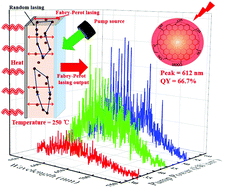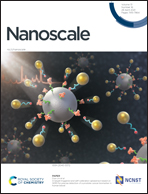Transformation of random lasing to Fabry–Perot lasing: observation of high temperature lasing from carbon dots†
Abstract
Carbon dots (CDs), a subject of academic research, have attracted intense attention due to their intrinsic merits of high stability, low cost, and low toxicity. However, the absence of highly efficient red-emitting CDs restricts their application in a variety of areas including lasers. In this work, red emissive CDs (R-CDs) with a quantum yield as high as 66.7% were prepared using 1,3-dihydroxynaphthalene as the initial source. It is found that the superior optical properties of R-CDs are attributed to the high oxidation degree and high ratio of hydroxyl functional groups on the surface of CDs. Red emissive random lasing at 612 nm was realized from a microcavity by using the R-CDs/epoxy composite as the gain medium at room temperature. Simultaneously, the transformation of random lasing to Fabry–Perot lasing in the same laser cavity at 250 °C was observed. This is on account of the declining optical gain which is insufficient to support random lasing in the microcavity at high temperatures. As a result, CD based Fabry–Perot lasing was achieved at a temperature as high as 250 °C for the first time.



 Please wait while we load your content...
Please wait while we load your content...